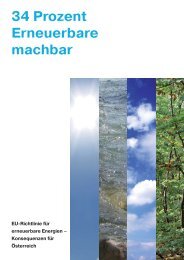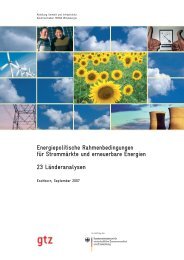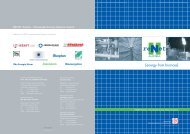K u rzfassu n g sb an d - Graz University of Technology
K u rzfassu n g sb an d - Graz University of Technology
K u rzfassu n g sb an d - Graz University of Technology
- Keine Tags gefunden...
Erfolgreiche ePaper selbst erstellen
Machen Sie aus Ihren PDF Publikationen ein blätterbares Flipbook mit unserer einzigartigen Google optimierten e-Paper Software.
92 Energieinnovation 2006<br />
Fuel savings potential <strong>of</strong> parallel hybrid cars<br />
There are two main points for improving the fuel consumption <strong>of</strong> a hybrid car compared to a<br />
conventional car. The first one is to avoid operating the CE in inefficient points. A CVT gives the<br />
possibility to meet this requirement for middle <strong>an</strong>d high power dem<strong>an</strong>ds. For low power dem<strong>an</strong>ds (e.g.<br />
for a const<strong>an</strong>t speed <strong>of</strong> 30km/h only about 3kW <strong>of</strong> power is needed) the efficiency <strong>of</strong> the CE is very<br />
poor. In such situations the over all efficiency c<strong>an</strong> be improved by cyclic operation <strong>of</strong> the CE.<br />
The second point is the recuperation <strong>of</strong> the kinetic energy during the breaking period. With using<br />
smaller EESD, the dem<strong>an</strong>d for optimized m<strong>an</strong>aging the state <strong>of</strong> charge aggravates vastly. On the one<br />
h<strong>an</strong>d the EESD should be charged as much as possible at st<strong>an</strong>dstill to provide enough energy for the<br />
next acceleration period. Furthermore the efficiency <strong>of</strong> the EESD ascends with rising state <strong>of</strong> charge.<br />
On the other h<strong>an</strong>d there should always be capacity inside the EESD to save as much breaking energy<br />
as possible during deceleration. The usable energy during breaking is depending on different<br />
nonlinear <strong>an</strong>d time vari<strong>an</strong>t influences like e.g. the maximum power <strong>of</strong> the electrical motor or the rate <strong>of</strong><br />
deceleration.<br />
To estimate the savings potential <strong>of</strong> a hybrid car compared to a conventional car simulations for each<br />
car with different driving cycles are used to calculate the fuel consumption. To get comparable results,<br />
the level <strong>of</strong> details for the simulations should be the same. By comparing the simulation results for the<br />
conventional car with results given by the m<strong>an</strong>ufacturer the model could be verified.<br />
Results<br />
Within this paper the possible fuel savings potential <strong>of</strong> a hybrid car compared to a conventional car will<br />
be shown. An <strong>an</strong>alytical method to calculate equivalent specific fuel consumption for a hybrid car<br />
driving with cyclic operation will be shown. The energy that c<strong>an</strong> be saved by regenerating breaking<br />
energy will be <strong>an</strong>alysed. The estimations will be verified by simulation results for a conventional car<br />
<strong>an</strong>d a hybrid car. Furthermore <strong>an</strong> outlook <strong>of</strong> fuel savings potential for different scenarios is exposed.<br />
Acknowledgement<br />
This Project is funded by the Deutsche Forschungsgemeinschaft (DFG), within the program<br />
Tr<strong>an</strong>sferbereich 38, "Optimierter Antriebsstr<strong>an</strong>g".<br />
Keywords: hybrid car, CVT, continuous variable tr<strong>an</strong>smission, double layer capacitor, UltraCap,<br />
operating strategy, fuel saving, fuel consumption, cyclic operation





